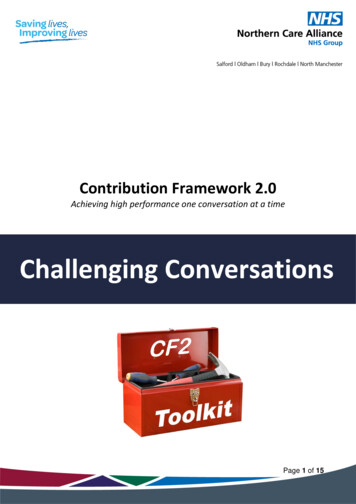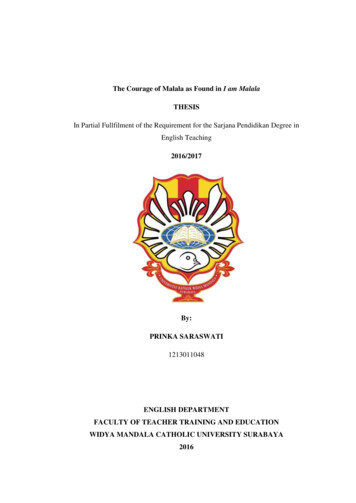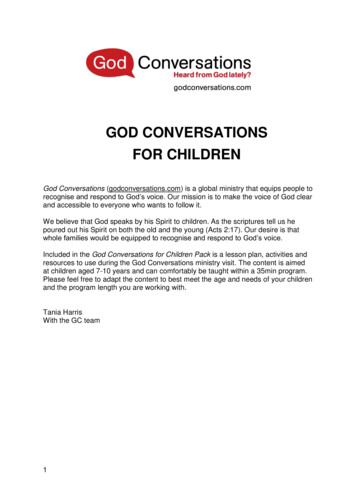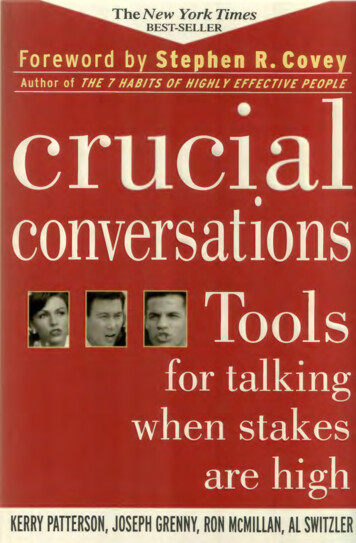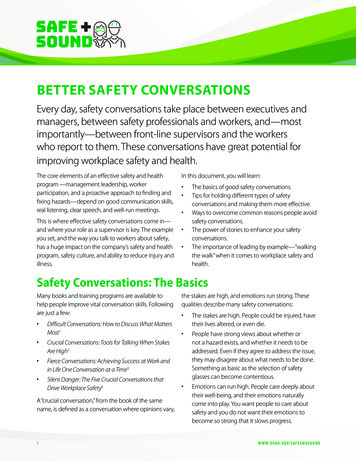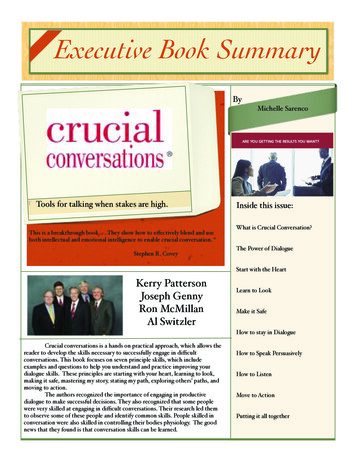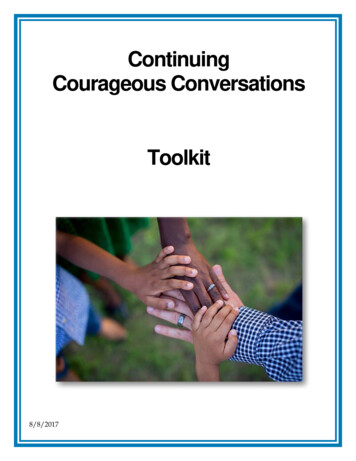
Transcription
ContinuingCourageous ConversationsToolkit8/8/2017
AcknowledgmentsFunded by:Iowa Department of Human ServicesDeveloped by:Lisa D’Aunno, JDMichelle Heinz, MSW graduate studentThe National Resource Center for Family Centered PracticeUniversity of Iowa School of Social WorkWith additional contributions by:Erin Kramer, M EdIowa State University Child Welfare Research and Training ProjectSandy Lint, LMSWIowa Department of Human ServicesSpecial thanks to Jolene Holden, Sue Strever, the Race: The Power of anIllusion (RPI) facilitators, and the Cultural Equity Alliance members. Theirknowledge and guidance was invaluable during the development of thisToolkit.
Human conversation is the most ancient andeasiest way to cultivate the conditions for change– personal change, community and organizationalchange, planetary change. If we can sit togetherand talk about what’s important to us, we begin tocome alive. We share what we see, what we feel,and we listen to what others see and feel.-Margaret Wheatley (2002)
ToolkitTable of ContentsIntroductory Materials . 1About the Toolkit . 1Ground Rules for Continuing Courageous Conversations1 . 3Exercises . 5Ice Breakers . 7Exercises. 11Learning about Microaggressions . 11Exploring our Racial Consciousness - Racial Autobiography11 . 15Exploring our Racial Consciousness – Race in My Life12 . 19The Courageous Conversation Compass13 . 21Understanding Privilege . 27Anti-Racist Bystander Intervention . 31Community Report Card18 . 33Face Test: Do I have the full picture?19 . 35Perspective Taking20 . 37Becoming Aware of Our Implicit Biases21 . 39Project Implicit http://implicit.harvard.edu/implicit . 41How to Overcome Our Biases . 43Stand Up and Declare Activity22. 45Page i
Speed Meeting Activity23 . 47Incorporating a Racial Equity Lens When Facilitating Dialogues24 . 51Resources. 53Videos and Movies . 53Books . 57Web Links for More Exercises/Tools . 59Meeting Tools. 61Sample Agenda for Self-Guided Facilitation . 61Discussion Guide for Planning Future Meetings. 63Guidance for Drafting Your Group’s Statement of Purpose . 64Continuing Courageous Conversations Meeting Sign-In SheetPage ii
ToolkitIntroductory MaterialsIntroductory MaterialsAbout the ToolkitThe purpose of the Continuing Courageous Conversations Toolkit is to provide support and tools forparticipants to take one or more “next steps” after the Race: The Power of an Illusion (RPI) learningexchange.The primary learning objective of the RPI learning exchange is to build organizational capacity to engage inongoing “courageous conversations” about the intersections of race, equity and child welfare by:1) Introducing key data, foundational concepts, frameworks and definitions2) Increasing knowledge about the development of the social construct of race and how public policyhas resulted in vastly unequal opportunities and disparities based on skin color3) Increasing awareness about racial and ethnic disparities in the child welfare and juvenile justicesystems4) Introducing the concept of courageous conversations about race5) Increasing participants’ comfort level in engaging in courageous conversations6) Encouraging participants to commit to take some additional action following the learning exchangeThe Toolkit is intended to be introduced at the RPI follow up meeting to reinforce the learning, comfortlevel and commitment made at the learning exchange. In addition, participants should feel free to use thetools provided in any community setting where others are willing to engage in courageous conversationsabout race.The Toolkit contains a number of group exercises designed to guide participants through a courageousconversation that can occur within a 20- to 45-minute time frame. The table of exercises on pages 5-6spells out the objective, time frame, and cultural competence goal of each exercise. A few of the exercisescall for a volunteer facilitator and some advance preparation; most do not. The exercises were selectedfrom a variety of sources (see references) and adapted for ease of use without a trained facilitator.The Toolkit has an optional meeting format that can be followed by a volunteer facilitator (see pages 6162).Page 1
Introductory MaterialsToolkitThe Toolkit also contains descriptions and links to other resources for courageous conversations aboutrace, including books, videos and movies and accompanying discussion guides (see pages 57-59).Conversations about race may raise feelings of indifference, guilt, shame, and mistrust. These feelings arevalid and expected, but they often result in avoiding important discussions that must occur before raceinequity can be addressed.The Ground Rules for Continuing Courageous Conversations are very important to review prior to engagingin any exercise in the Toolkit. The group is encouraged to read the ground rules aloud and to ask for eachperson’s verbal agreement to abide by them. It is also a good idea to see if the group wishes to suggest anyadditional ground rules.Page 2
ToolkitIntroductory MaterialsGround Rules for Continuing CourageousConversations1Read aloud:Courageous conversations are dialogues in which participants commit to engage each other with honesty,open-mindedness, and vulnerability; to listen deeply to better understand each other’s perspective; and to“sustain the conversation when it gets uncomfortable or diverted”2. The goal of Ground Rules forContinuing Courageous Conversations is to be able to have a conversation about race without excessivefear of being labeled racist, biased or bigoted, to avoid blaming or being blamed, and to avoid discountingor invalidating the experiences and feelings of others.To that end, we agree to follow these ground rules:Stay Engaged Give yourself permission to focus fully on the conversation topic or exercise at hand.Please silence your cell phone.Share a story, state your opinion, ask a question—risk and grow!Speak Your Truth Value everyone’s thoughts.Start by assuming good intentions.Speak from your own experience and use “I” statements, as in “I think”, “I feel”, “I believe”, or“I want”. 3It’s important that we create a safe environment where everyone is free to speak openly.Keep in mind that people are in different places in this work. In order for us to grow, people need to beable to share thoughts in a way that’s comfortable for them.Be aware of non-verbal communication.Before speaking, think about what you want others to know. How can they best hear you?Mistakes are part of success. Don’t be overly cautious about being politically correct – this is a learningprocess.Disagree respectfully.Listen for Understanding Listen without thinking about how you are going to respond. Try to understand where another person is coming from as best you can. Be careful not to compare your experiences with another person’s. This often invalidates or minimizesa person’s experiences. If someone is pointing out how what you said left them feeling, try not to explain or rationalize whatyou said or why you said it. Sometimes positive intent is not enough. Sometimes it’s necessary to justsay, “I didn’t realize what I said was inappropriate or hurt you in that way, I’m sorry,” etc. Be comfortable with being uncomfortable.Page 3
Introductory MaterialsToolkitHonor Confidentiality What is shared here, stays here.Expect and Accept Non-closure Engaging in race conversations is ongoing work that does not necessarily leave a person walking awayfeeling everything turned out the way they hoped. Accept that much of this is about changing yourself,not others.Responsibility to Each Other and to the Courageous Conversation Process Group members will encourage each other to follow the ground rules.Additional Ground Rules Agreed to by the Group (optional) Participants are invited to propose additional ground rules for courageous conversations. The groupmay wish to discuss before deciding whether they agree to abide by additional ground rules. If so, theadditional ground rules should be written out for everyone to see.Sources: Race: The Power of an Illusion Learning Exchange; www.culturesconnecting.com; Singleton (2006) CourageousConversations About Race: A Field Guide for Achieving Equity in Schools 1st ed.12Singleton (2016) Courageous Conversations About Race: A Field Guide for Achieving Equity in Schools 2nd ed.”I” statements allow the speaker to express their feelings without blaming someone or inferring the intent of someone else. Theformula for an “I” statement or message is: I feel when happens because.3Page 4
ToolkitIntroductory MaterialsExercisesPageExerciseTimeLearning ObjectiveIcebreakersvariesTo encourage everyone to participate through initialconversation starters7Learning aboutMicroaggressions45 min To define microaggressions, recognize their hidden meaningand learn ways to avoid committing them11RacialAutobiography45 min To increase awareness of our own racial experiences as well aslearning from others15Race in My Life45 min To establish a racial context that is personal, local, andimmediate (follow up to Racial Autobiography exercise)19The CourageousConversationCompass45 min To think about how individuals deal with racial information,with the goal of being able to better understand where peopleare coming from21UnderstandingPrivilege30 min To understand personal privilege and how it can be used toconfront Community ReportCard45 min To think about whether individuals from racial and ethnicgroups in our community have equal access to services33Face Test25 min To explore the extent to which our experiences have exposedus to racial diversity and how it may affect our perspectives35Perspective Taking20-45minTo better understand how our backgrounds affect ourperspectives and how we relate to our neighbors andcommunity37Becoming Aware ofOur Implicit Biases(Badges)20 min To become aware of our implicit biases and discuss the impacton our experience of difference39To practice a skill; namely, to learn how to intervene when aperson is harassing someone or saying racist remarksPage 5
Introductory MaterialsToolkitProject Implicit20 min To explore our implicit biases and discuss strategies forchanging them41How to OvercomeOur Biases30 min To learn strategies for overcoming personal bias43Stand up andDeclare Activity25 min To share information about ourselves with one another45Speed MeetingActivity45 min To become comfortable talking about race/ethnicity andreflect on past and present experiences47Incorporating aRacial Equity LensWhen FacilitatingDialogues50 min To increase awareness of how racial dynamics can impact ourwork as dialogue facilitators, and learn how to work togethermore equitably as a team51Page 6
ToolkitIce BreakersIce BreakersThe following list of ice breakers and exercises can be used at the start of meetings as a “warm up” to geteveryone talking at the beginning of the meeting before more difficult conversations are introduced.1. Culturally Decorate Your Name Tag4: Decorate your name tag in a way that you identify culturally.Culture is defined in any way you want to define it. Once name tags are decorated, participants willshow their name tag and share why they decorated it in that manner.2. What’s in a name?4 Each person takes a turn introducing themselves, where they are from, andsays something about the origin of their name, for example its meaning or significance. Are thereany cultural reasons why their parents chose those names?3. Cultural Introduction4: Pair up with someone you do not know, or know very little, and introduceyourself to that person. This is going to be different than your normal introduction. Pleaseintroduce yourself in a “cultural manner.” Define culture in the broadest context. It may meandescribing who you are by ethnicity, race, language, family, spiritual beliefs, religious affiliation,generation, sexual identity, birth order, or any self-identifying manner. There are two rules: Pleasedo not share what you do professionally, your job, position, degrees or title, and do not ask anyquestions of the other person. Listen only, while the other person is speaking. Then switch to allowthe other person to introduce themselves. Spend 2-3 minutes each.Then discuss: How did it feel to:Introduce yourself without describing what you do?Listen without asking questions?4. What would you most like to be remembered for when you are reminiscing about your life in yourold age?55. What aspect of your personality adds the most value to the world?56. If you could choose any one person, living or dead, whom would you most want to emulate? Sharewhy.57. Small Group Things in Common6o Procedures: Break into groups of 3-10, (depending on group size), and as a group come upwith as many things you, as a group, have in common that you cannot see (e.g. not clothesor hair). Each group has two minutes to come up with as many things as they can. At theend of two minutes, have each group share their lists. You can do this for two or threerounds with a different group pairing each time.o Debrief/Reflection: Ask individuals “What was one thing you had in common with someonein the group that surprised you?” Ask the groups to share what they think is their mostunique or interesting commonality.Page 7
Ice BreakersToolkit8. 7 Circles6o Procedures: Draw a medium-sized circle in the center of a piece of paper. Around that circle,draw seven smaller circles connected to the larger circle. Write your name in the centercircle. In the smaller circles, write the names of seven groups with which you identify(examples: gender, nationality/ethnicity, religious affiliation, political stance, geographic ties,family role etc.)o Debrief: Ask individuals to get in small groups and answer the following questions: Talk about at time when you felt proud to be a member of a certain group. When did it feel painful to be a member of a certain group?9. Thumball Activities7 (These conversation starters are a little bit more intense and would be bestused after a review of the Ground Rules for Continuing Courageous Conversations):o Share a situation when you were in the minority.o Describe a time you witnessed discrimination.o How do your thoughts about diversity differ from your parents?o Where do you see prejudice?o How can we promote acceptance of differences?o How might you personally combat discrimination?o What are the benefits of diversity?10. Cultural Scavenger Hunt8: This is an interactive exercise that allows participants an opportunity toget to know each other from a cultural vantage point. This exercise illustrates the cultural dynamicsand experiences individuals bring to the group setting. Individuals or teams are given the ScavengerHunt List. They then circulate around the designated space to obtain initials of people who match adescription on the list. Any individual can initial another person’s sheet only once (see next page).Source: Cultural and Linguistic Competence Icebreakers, Exercises, Videos and Movies (2012) Technical Assistance %20Handouts.pdf45Source: Thoughtful Team Builder Questions to Use as Ice Breakers6Source: The Balance 67Source: Diversity ThumballSource: Cultural and Linguistic Competence Icebreakers, Exercises, Videos and Movies (2012) Technical Assistance %20Handouts.pdf8Page 8
ToolkitIce BreakersCultural Scavenger HuntDIRECTIONS: Circulate around the room and find people who fit the description on your list. When a person fits aparticular description, ask them to initial your sheet. Any individual can initial another person’s sheet only once. Youcan add your own items.1. Knows a folk dance or line dance.2. Has American Indian/Alaskan Native ancestry.3. Has attended a religious service of a religion other than their own.4. Has attended a Kwanzaa celebration, or knows what Kwanzaa is.5. Has visited another continent.6. Plays a musical instrument or is a vocalist.7. Has used crutches, a wheelchair, a cane, or has worn a cast on a limb.8. Is bilingual, or has relatives who speak a language other than English.9. Knows some American sign language.10. Has studied a foreign language.11. Lived in another country part of his/her life.12. Is of mixed race or ethnicity.13. Is an animal lover and has had more than one pet.14. Grew up in a poor or low-income community.15. Has a member of their family with a mental health condition.Suggestions for processing/debriefing the Cultural Scavenger Hunt What are people’s thoughts about the exercise?How many were comfortable? How many were uncomfortable? Why/why not?Did anyone have preconceived thoughts that were confirmed or debunked?Did you learn something new about someone?Page 9
Ice BreakersPage 10Toolkit
ToolkitExercisesExercisesLearning about MicroaggressionsTime to complete this lesson: 45 minutesLearning Objective: To define microaggressions, recognize their hiddenmeaning and learn ways to avoid committing themSet-Up Materials needed: copies of Microaggressions Worksheet,notebook/paper Need one volunteer to watch time and ask group to move on to the nextsection when needed For read aloud sections, group can decide if they want to read aloud orindependentlyPart 1:Read aloud: What are microaggressions? Microaggressions are brief, every day, verbal, behavioral andenvironmental exchanges, both unintentional and intentional, that send disparaging messages toindividuals based on their group membership. Microaggressions can have a serious impact and should notbe dismissed because of their brief or often unintentional nature. Researchers have linked continuousexposure of microaggressions to depression, anxiety-related symptoms, diminished psychological wellbeing and physical health.9Behavioral examples of microaggressions and possible hidden meanings behind them are: A white person grabs their purse or wallet as an African American or Latino approaches them. (Thisis an assumption of criminality.) A white individual waits to ride the next elevator when a person of color is on it. (This is also anassumption of criminality.) Mistaking a person of color as a service worker (Treating an individual as a second class citizen)Verbal examples and possible hidden meanings are: “You are so articulate.” (Believing people of color are less intelligent than whites) “I don’t see color.” (I don’t want to acknowledge race) “You speak great English.” (Assuming someone is foreign born) “I’m not racist. I have several black friends.” (Denial of any individual racism – because I havefriends of color I can’t be racist)Page 11
ExercisesToolkitDiscuss: (15 minutes)One member of the group will read each bullet and then the group will discuss: Have you experienced microaggressions? How did it make you feel? Some feel that since microaggressions can be unintentional, that people should just “let it go” ornot dwell on them when they occur. Do you agree with that? Why or why not?Exercise: (5 minutes)One member reads the instructions aloud, then all members do the Microaggressions Worksheet10.Instructions: On your worksheet, draw a line connecting the statements in the first column to thepossible interpretations in the second column. There may be multiple possible interpretations for eachstatement. Think about how these statements can be interpreted as disparaging remarks.Discuss: (10 minutes) How did it feel to connect the statements to the possible interpretations?Did this exercise make you aware of any microaggressions you may have committed? If so, howdoes it feel?Read aloud: It is important to acknowledge that everyone has committed or experiencedmicroaggressions. Part of eliminating microaggressions from a normative place in our society is learning torecognize them and also admitting if you are guilty of using one. If you commit a microaggression andsomeone calls you on it, stop and listen to that individual. Do not dismiss someone when they feel amicroaggression has occurred. Try and avoid becoming defensive. Instead, be open to discussing andclarifying the matter. Afterward, acknowledge your own cultural conditioning and biases which may havecontributed to your actions and think about how to challenge those personal biases.9Source: Sue (2010) Microaggressions in Everyday Life : Race, Gender, and Sexual OrientationSource: Breaking the Habit: Microaggressions .pdf10Page 12
ToolkitExercisesPart 2:Exercise: (5 minutes)One member reads the instructions aloudThink of a microaggression you have personally committed, received, or heard. How could it becommunicated without the microaggression? For example: “How long have you lived in this country?”suggests an incorrect assumption that the person is a foreigner. Instead you could ask “How long have youlived in this city?” Try rewriting the microaggression. After writing the microaggression, share it with theperson next to you.Discuss: (5 minutes) Was it difficult or easy to rewrite the statement?Have you been called out on committing a microaggression? How could you have rephrased it?Page 13
ExercisesToolkitMicroaggressions WorksheetDraw one or more lines connecting the statements in the first column to the possible interpretations in thesecond column. There may be multiple possible interpretations for each statement. Think about howthese statements can be interpreted as disparaging remarks.Column A:StatementsColumn B:Possible Interpretations“Don’t be such a sissy.”Feminine traits are undesirable.“Of course you have a badrelationship with your parents.You’re gay.”People with disabilities are lessimportant, likeable or competent.“You speak English very well.”“America is a melting pot.”“I don’t see color.”“I have Black friends, so what. Isay isn’t offensive.”“Everyone knows Blacks are morelikely to shoplift.”[A professor asks a Latina student infront of a class] “What do Latinas thinkabout this situation?”“That’s retarded.”You don’t belong.Being gay is unacceptable.Your sexual orientation is your mostimportant characteristic.You are not man enough.Your culture is your most definingfeature.People of your background areunintelligent.You look like a criminal.I see you as your skin color only.You are not American.Follow up:For tips on how to interrupt and respond to microaggressions nts/Microaggressions InterruptHO 2014 11 182v5.pdfPage 14
ToolkitExercisesExploring our Racial Consciousness:Racial Autobiography11Time to complete this lesson: 45 minutesLearning Objective: To increase awareness of our own racial experiences aswell as learn from othersSet-Up: Need one volunteer to watch time and ask group to move on to thenext section when neededRead aloud: Many of us, whether we are White, of color, or indigenous, are inhibited when conversingabout race and racial issues. This is due in part to limited awareness of our own racial experience and theexperience of others who have different racial backgrounds and perspectives. (Singleton, 2015). In thisexercise, the group will read and discuss two racial autobiographies written by Andrea Johnson and MelissaKrull. The group can decide if they want to read them out loud, or on their own. While reading throughthese, pay attention to when the authors become aware of their race, and how they describe their racialexperiences. After reading, we will discuss the pieces, as well as our own personal experiences.Andrea Johnson’s Racial Autobiography:I am a proud Sista girl from Detroit. I was born and raised in one of the many middle-classneighborhoods of northwest Detroit. Mine was a staunch, White Catholic community in the 1940sand early 1950s and then became a largely White Jewish community in the late 1950s and early1960s. By 1965, redlining waned, and Black families like mine peppered each block, one or twofamilies at a time. Our home was a beautiful three-bedroom brick Tudor with a fireplace, abreakfast nook, and a screened back porch. In Detroit, in a pattern that differed from that of manycities across the country, when the Black folks moved in, the White people did not move out – atleast not right away. Throughout most of my formative years, I lived in a real integratedneighborhood.The Black middle class was alive and well throughout my youth. We had a Black mayor, Blackaccountants, Black doctors, and Black lawyers. The superintendent of schools was Black, as weremany of the school board members, police officers, and a growing number of fire fighters. Thepeople who worked on the assembly lines in the auto factories made a middle-class wage and livedright beside us in beautiful single-family brick homes with a backyard and a two-car garage.Everyone in my peer group was college bound, and most of our friends’ parents had gone to college.Our elementary school had a Black principal and both Black and White teachers. One of myteachers, Catherine Blackwell, had a profound impact on me during those formative years. M rs.Blackwell was Black. She travelled frequently to various countries in West Africa and brought backPage 15
ExercisesToolkitartifacts to share with her students. Some students, Black and White, including me, would wrap herbrilliant fabrics on our bodies and heads in traditional style and learn African dance, while others ofus played rhythms on her authentic African drums. Mrs. Blackwell had all of us memorize and recitethe poetry of Langston Hughes, Margaret Walker, and other Black poets as well as the poems ofWhite poets such as Robert Frost and T.S. Eliot. She taught us about American jazz and Europeanclassical music. We listened to and had to identify “great” composers like Coltrane, Ellington, andMiles Davis as well as Mozart, Haydn, and Tchaikovsky.Each time I have reached into my memory in an effort to recall my first experiences with racism, myrecollections have gone deeper into my younger self. At first, I dusted off an incident from my early30s. I accepted this memory as a “first,” because it was the first time I’d lived in a predominantlyWhite community in a white-collar suburb of Detroit. I was followed by the police while driving ourvery suburban-looking minivan to the bank. As I pulled into the parking lot, a second police cararrived as “reinforcement,” and I was given a ticket, because although my driver’s license had anexpiration month of September (and it was September 9th), my actual birth date was the 4th, andtherefore the officers determined
5) Increasing participants’ comfort level in engaging in courageous conversations 6) Encouraging participants to commit to take some additional action following the learning exchange The To
